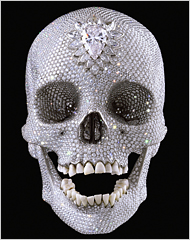What is it that’s both worthless and expensive . . .
Lauren Purje sent me a link to a blog post in the Guardian by Anthony Gormley calling for the return of melancholia in art. In his post, he says art over the past few decades has become a fashionable and fun way for one-percenters to park their wealth, as a diversion from the uncertainties of Wall Street or, say, Greek bonds—no argument there. He said, as a result, art has turned itself into an amusement, so that the least substantial work fetches the highest price. He would like to see a return to “serious” work, work that emphasizes mortality in a way that doesn’t amuse—just the skull, please, hold the diamonds. Who wouldn’t argue with the value of the late Goya, Brueghel, Guernica . . . add your favorite “dark” artist here. But somehow something has gone missing in this perfectly respectable harrumph about money. Gormley’s point would make Van Gogh’s potato eaters the pinnacle of his achievement. What happens to the joy of all the later, fully realized work, which helped make Modernism possible? Lauren writes:
“I don’t know if I’m part of the solution or part of the problem according to this guy—haha. Or if I agree or disagree. I definitely don’t like gold bricks.”
I want to get down, for the record, that I love gold bricks—I extend an open invitation to all gold bricks who wish to enter my life—as long as they’re in a vault, not on exhibit in a gallery. Gold bricks, though, they never hear my call. Just ask the fellow who does my taxes and calls me with that funereal tone every year, which says, is this all you made? My response to Lauren:
“He’s like Tom Wolfe in the way he overstates everything. I think he’d like your work, actually–you certainly focus on Continental philosophy’s “problem of existence.” My painting wouldn’t be depressing enough. I guess he’d toss out Matisse who wanted art to feel like an easy chair you fall into at the end of the day. Hm, where is the dark night of the soul in Matisse, and he was, let me get this right now, the greatest painter of the 20th century. It’s a toss up between him and Picasso, for Schjehldahl. Have to pay a visit to Picasso for the horrors, though. In my last post, on my friend Harrington, I talked about Hickey’s view that art needs to find it’s buyers and that the effort to connect in ways that make people want to own something because they love it, not because they’ve been told it’s good for them. His view is that this was slowly lost since the Baroque era. Typical Hickey: let’s go back a few centuries to the root of the problem. I agree with his view and yet I’m constantly thinking, “but this would make Koons and Hirst his heroes.” I’m sure Hickey would disagree. The more you ponder these things, the more you see the holes in any particular “stance” about what’s bad in art. You make the art you make and then let others confuse the issue by talking about it. As a rule, maybe I should talk less and paint more.”
If art is great, it can show you nothing more than the beauty of a summer day, or a woman’s face. It can take the slightest thing and turn it into a revelation. There doesn’t need to be a trace amount of the tomb in it. If it’s meretricious BS, it can do exactly the same thing, show you a lovely afternoon or a beautiful face in a way calculated to earn an inflated price. The role of a critic is to separate the genuine joy from what’s merely an extremely expensive pleasure. Gormley seems to simplify everything down to the dictum that art has to be depressing to be good. Should I list the hundreds of great artists he would need to banish from his roster? I think the bulk of Vermeer would have to go, for starters.

Comments are currently closed.